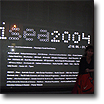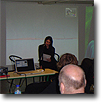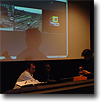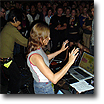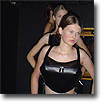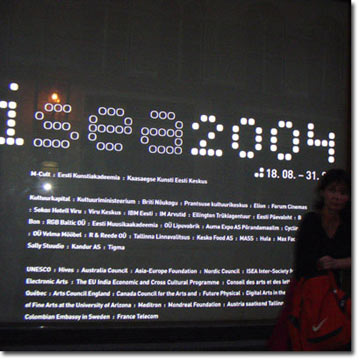ISEA: International Symposium of Electronic Art,
Aug 15, 2004 - Aug 17, 2004
Montréal, Canada
ISEA 2004: 12th International Symposium of Electronic Art
by Andrés Burbano
The idea of an "ocean crossing" is common when talking about the result of meaningful journeys at the conceptual, aesthetic or even technical levels. The node which plays home to the ISEA 2004 event is a place where this crossing is seen not only as a metaphor, but as a practical necessity in order to take on Art’s problems in terms of its relationships with its geographical, social and technological surroundings. First: the boat trip on the Baltic Sea between Helsinki, Stockholm and Tallinn. Tallinn, the capital of Estonia, hosts the second part of the event, before the trip continues on to Helsinki where the event closes. The first tentative name for ISEA 2004 was "When the New Technologies Became Old" in reference to the book by Carolyn Marvin "When Old Technologies Were New". This anticipated the idea of a platform from which technologies are not seen merely from a commercial point of view, where the latest developments eclipse all other points of view, but which focuses instead in terms of the social use of technologies, providing a conceptual platform that can be used to look at the complex problem of Art through new or old-new media. The event was structured in terms of what the organizers called "conferences" and "experiences". The "conferences" operated as a wide range of meetings for theories and reflection, whereas the "experiences" were a diverse collection of exhibitions, live events, events in public spaces, performances, concerts, etc., focusing on the problems faced at this moment in time. In this sea of movement, it was difficult to get a clear idea of what was going on in general at ISEA 2004, as the event was so wide-ranging, diverse and synchronous. The Helsinki conferences alone, for example, had 6 parallel session panels over the three days. In this way, around 600 participants, including artists, theorists, critics and curators, catalyzed a project which aimed to mark a clear cut-off point in the state of the art of Electronic Art and its links to other nodes to knowledge and reality. There was participation from artists and theorists from a range of fields from Latin America, including those who formed part of the IPC, International Program Committee, a large, multidisciplinary and worldwide group in charge of proposing the selection of works that were to be included within the framework of the show; these included Rejanne Spitz and Artur Matuck from Brazil, María Fernández from USA/Nicaragua, and Andrés Burbano from Colombia, among others. Likewise, there were those who took part in the exhibitions, conferences and parallel events; among those involved were Karla Schuch Brunet and Artur Matuck from Brazil, José Carlos Mariategui and Angie Bonino from Peru, and the Quiasma Group from Colombia. Indeed, even one of the Key Speakers invited was the Colombian anthropologist Arturo Escobar; however, unfortunately he could not make it for personal reasons. I say unfortunately because Escobar’s perspective would have been particularly appropriate for the theoretical approach discussed in Estonia. Baltic Sea, Boat. August 15 and 16. "interfacing sound experience" and "networked experience". The activities on the boat were marked by intense audio experiences, where the sessions by Félix Kubin, Fabrice Lig, or Scanner stood out, amongst many others. The selection of sound artists showed a particular focus on the nature of music and sound as an interactive performance system, based especially on the new generation of projects that take on the visual and audio together in real-time explorations. This part of the event was developed as a co-production together with Finland’s Koneisto electronic music festival The second day of activities on the boat saw the start of the meetings for theories and reflection. Particularly interesting was seeing artists,
|
